Certainly! Here’s a list of 10 air-purifying plants that are known for their ability to improve indoor air quality
Snake Plant (Sansevieria trifasciata)
A hardy and low-maintenance plant that excels at removing toxins like benzene, formaldehyde, and trichloroethylene.
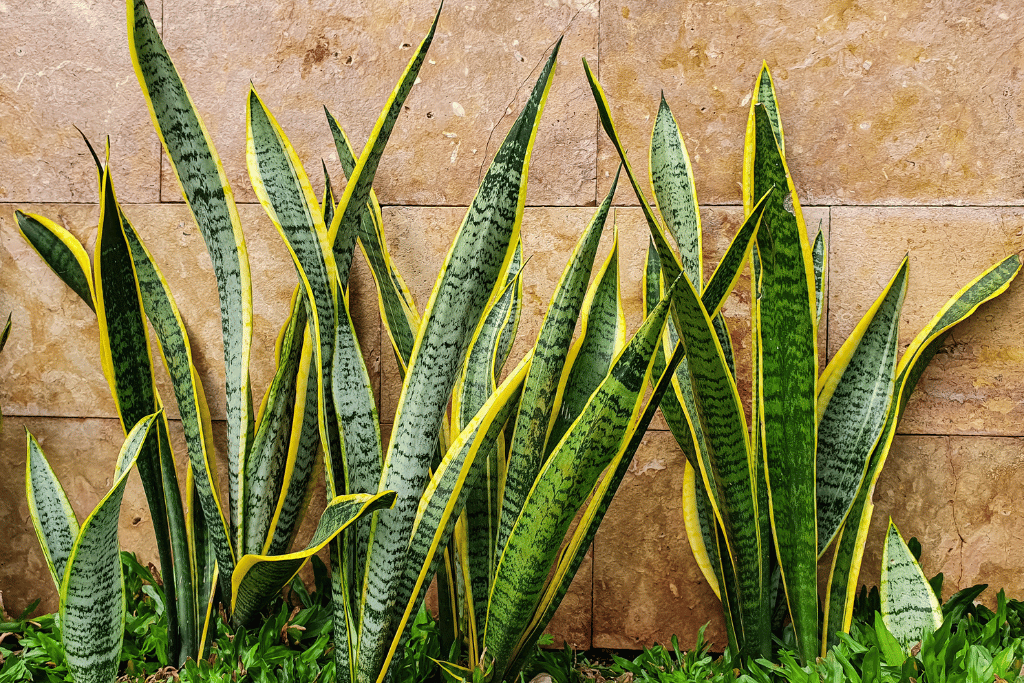
The Snake Plant, scientifically known as Sansevieria trifasciata, is a popular indoor plant celebrated for its unique appearance and air-purifying qualities. Also commonly referred to as the “Mother-in-Law’s Tongue” or “Saint George’s Sword,” this plant is native to West Africa.
Key Features:
Appearance: The Snake Plant has long, upright leaves that are typically green with distinctive horizontal bands or variegation.
Hardiness: Known for its resilience, the Snake Plant can thrive in various conditions, including low light and neglect, making it an excellent choice for those new to plant care.
Air Purification: One of its standout features is its ability to filter and purify indoor air. It efficiently removes toxins such as benzene, formaldehyde, trichloroethylene, and other harmful pollutants.
Low Maintenance: This plant is low-maintenance and doesn’t require frequent watering. In fact, it can tolerate drought conditions and prefers to dry out between waterings.
Adaptability: Suitable for both homes and offices, the Snake Plant can adapt to different light levels, from indirect sunlight to low-light environments.
Care Tips:
Light: While it can tolerate low light, the Snake Plant thrives in indirect sunlight. Avoid exposing it to harsh, direct sunlight for extended periods.
Watering: Allow the soil to dry out between waterings, as overwatering can lead to root rot. Water sparingly, especially during the dormant winter months.
Soil: Well-draining soil is essential to prevent waterlogging, as Snake Plants prefer slightly dry conditions.
Temperature: It is tolerant of a wide temperature range but prefers warmer conditions. Protect it from cold drafts and extreme temperature fluctuations.
Whether you’re looking to enhance your indoor decor or improve air quality, the Snake Plant stands out as a stylish and functional choice, requiring minimal effort to thrive.
Spider Plant (Chlorophytum comosum)
Known for its effectiveness in reducing indoor air pollutants such as formaldehyde and xylene. It’s easy to grow and maintain.
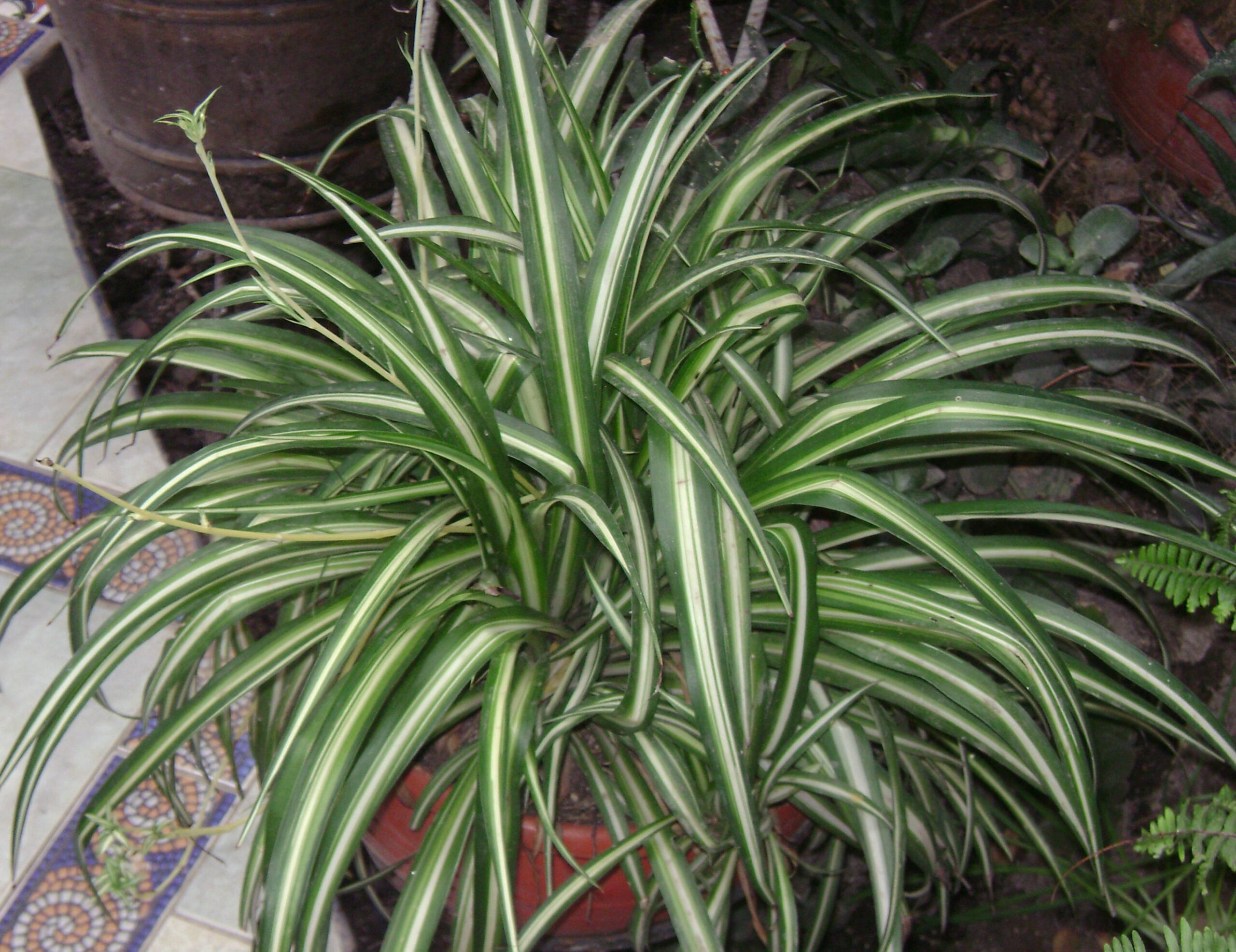
The Spider Plant, scientifically known as Chlorophytum comosum, is a popular and visually appealing indoor plant appreciated for its distinctive arching leaves and air-purifying capabilities.
Key Features:
Appearance: Spider Plants have long, arching leaves that are typically green with white stripes or variegation, resembling spider legs. They often produce hanging plantlets or “pups” on long stems.
Air Purification: Known for its effectiveness in improving indoor air quality, the Spider Plant helps remove common pollutants such as formaldehyde and xylene.
Adaptability: This plant is adaptable to various indoor conditions and is suitable for both hanging baskets and pots. It’s a common choice for homes and offices due to its easy care.
Propagation: Spider Plants reproduce readily through the plantlets that emerge on long stems. These can be potted to create new plants, making it a great option for plant enthusiasts.
Low Maintenance: Spider Plants are resilient and relatively low-maintenance. They can tolerate a range of light conditions, from indirect sunlight to partial shade.
Care Tips:
Light: While they can thrive in indirect sunlight, Spider Plants are adaptable and can tolerate lower light conditions. Avoid prolonged exposure to direct sunlight.
Watering: Allow the soil to dry out between waterings, and water moderately. Overwatering may lead to root rot, so it’s best to let the top inch of soil dry before watering again.
Soil: Well-draining potting mix is suitable for Spider Plants. They are not overly picky about soil conditions.
Temperature: Spider Plants prefer average room temperatures and should be protected from drafts and temperature extremes.
Whether you’re looking to add a touch of greenery to your living space or improve air quality, the Spider Plant is a versatile and charming choice that requires minimal effort to thrive.
Peace Lily (Spathiphyllum)
This elegant plant not only adds beauty but also helps eliminate common indoor pollutants like ammonia, benzene, and formaldehyde.

The Peace Lily, scientifically known as Spathiphyllum, is a popular and elegant indoor plant admired for its lush green foliage and distinctive white flowers. Here’s a closer look at its key features and care tips:
Key Features:
Floral Beauty: The Peace Lily is renowned for its graceful white blooms, which are not true flowers but rather specialized leaves called spathes surrounding a central spadix.
Air Purification: Beyond its aesthetic appeal, the Peace Lily is celebrated for its air-purifying qualities. It effectively filters out common indoor pollutants such as ammonia, benzene, and formaldehyde.
Adaptability: This plant is adaptable to different light conditions, making it suitable for both homes and offices. While it thrives in bright, indirect light, it can tolerate lower light levels.
Low Maintenance: Peace Lilies are relatively low-maintenance. They give visual cues when they need water, as their leaves will droop. A good watering typically revives them quickly.
Pet-Friendly: Peace Lilies are considered to be less toxic to pets compared to some other indoor plants, though it’s still advisable to keep them out of reach.
Care Tips:
Light: While they can tolerate low light, Peace Lilies prefer bright, indirect light. Avoid direct sunlight, as it can scorch their leaves.
Watering: Keep the soil consistently moist but not waterlogged. Water when the top inch of the soil feels dry, and allow excess water to drain away.
Humidity: Peace Lilies appreciate higher humidity levels. Misting the leaves or placing the pot on a tray filled with water and pebbles can help maintain humidity.
Temperature: They prefer average room temperatures and should be protected from drafts and sudden temperature changes.
Fertilization: Feed the plant with a balanced liquid fertilizer during the growing season (spring and summer), but reduce or eliminate fertilization in the dormant season (fall and winter).
Whether you’re drawn to its aesthetic charm or its air-purifying benefits, the Peace Lily is a versatile and rewarding addition to indoor spaces.
Aloe Vera (Aloe barbadensis miller)
Apart from its soothing gel, Aloe Vera is a natural air purifier, particularly effective against formaldehyde and benzene.

Aloe Vera, scientifically known as Aloe barbadensis miller, is a versatile and popular succulent celebrated for its soothing gel and various health benefits. Here’s a closer look at its key features and care tips:
Key Features:
Succulent Form: Aloe Vera has thick, fleshy leaves that are green and lance-shaped, with serrated edges. The leaves contain a gel-like substance known for its moisturizing and healing properties.
Healing Properties: The gel inside Aloe Vera leaves is widely used for its medicinal properties, including treating sunburns, skin irritations, and promoting wound healing.
Air Purification: While not as prominent as some other indoor plants, Aloe Vera can contribute to improving indoor air quality by filtering out certain pollutants.
Adaptability: Aloe Vera is adaptable to a variety of growing conditions. It thrives in well-draining soil and is often grown in pots or containers indoors.
Low Maintenance: This succulent is relatively low-maintenance, requiring well-draining soil, infrequent watering, and bright, indirect light.
Care Tips:
Light: Aloe Vera prefers bright, indirect light but can tolerate some direct sunlight. Inadequate light may result in elongated, leggy growth.
Watering: Allow the soil to dry out between waterings, as Aloe Vera is drought-tolerant. Overwatering can lead to root rot, so it’s crucial not to let the soil stay consistently wet.
Soil: Use a well-draining cactus or succulent mix. Aloe Vera plants dislike standing water, so ensure that the pot has drainage holes.
Temperature: Aloe Vera prefers warmer temperatures but can tolerate some fluctuations. Protect it from cold drafts and extreme temperature changes.
Fertilization: Fertilize sparingly, as Aloe Vera doesn’t require frequent feeding. Use a diluted, balanced fertilizer during the growing season (spring and summer).
Whether you’re cultivating Aloe Vera for its aesthetic appeal or the beneficial properties of its gel, it’s a resilient and practical addition to both indoor and outdoor gardens.
Rubber Plant (Ficus elastica)
A popular choice for indoor spaces, the Rubber Plant is known to remove pollutants like formaldehyde, making it beneficial for air quality.

The Rubber Plant, scientifically known as Ficus elastica, is a popular and robust indoor plant appreciated for its glossy, broad leaves and air-purifying qualities. Here’s a closer look at its key features and care tips:
Key Features:
Large, Shiny Leaves: The Rubber Plant boasts large, dark green leaves with a glossy sheen, lending a lush and vibrant appearance to indoor spaces.
Air Purification: Recognized for its effectiveness in removing indoor air pollutants, particularly formaldehyde. It contributes to creating a healthier indoor environment.
Sturdy Growth: Ficus elastica is a robust and upright plant that can grow to be quite tall if given the space and proper care.
Adaptability: This plant is adaptable to various light conditions, making it suitable for both homes and offices. It can tolerate lower light levels but prefers bright, indirect light.
Low Maintenance: The Rubber Plant is relatively low-maintenance and can thrive with consistent care. It’s a good choice for those looking for a visually striking yet manageable indoor plant.
Care Tips:
Light: While it can tolerate lower light conditions, the Rubber Plant prefers bright, indirect light. Avoid exposing it to harsh, direct sunlight for extended periods.
Watering: Allow the top inch of soil to dry out between waterings. Overwatering can lead to root rot, so it’s crucial to strike a balance and avoid waterlogged soil.
Humidity: Ficus elastica appreciates higher humidity levels, but it can adapt to average indoor humidity. Regular misting or placing a tray of water near the plant can help maintain moisture.
Temperature: Keep the Rubber Plant in a warm and stable environment. Protect it from drafts and temperature extremes.
Fertilization: Feed the plant with a balanced liquid fertilizer during the growing season (spring and summer). Reduce or eliminate fertilization in the dormant season (fall and winter).
Whether you’re looking to enhance the aesthetics of your living space or improve air quality, the Rubber Plant is a stylish and functional choice that adds a touch of greenery to any room.
Boston Fern (Nephrolepis exaltata)
Acts as a natural air humidifier and removes pollutants like formaldehyde and xylene.
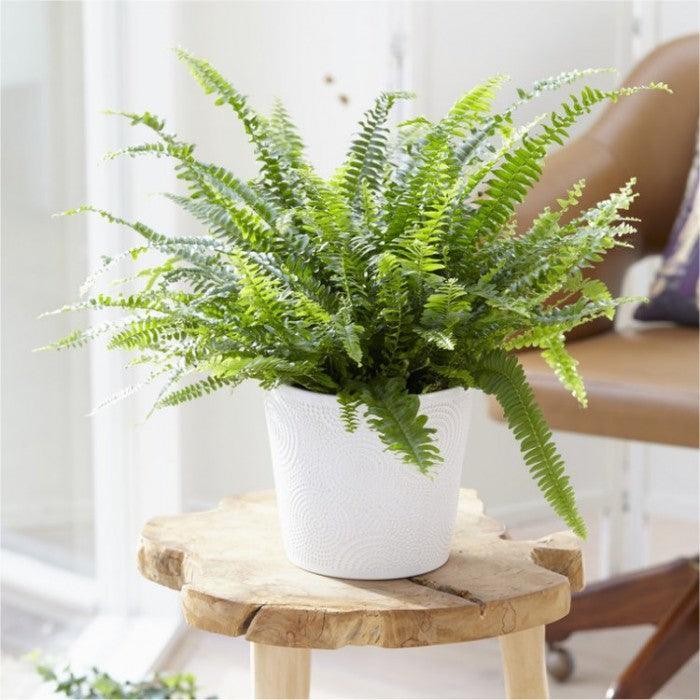
The Boston Fern, scientifically known as Nephrolepis exaltata, is a popular and graceful indoor plant recognized for its feathery fronds and air-purifying properties. Let’s explore its key features and care tips:
Key Features:
Feathery Foliage: Boston Ferns have delicate, arching fronds with small leaflets, creating a lush and airy appearance that adds a touch of elegance to indoor spaces.
Air Humidification: One of the notable features of the Boston Fern is its ability to act as a natural air humidifier. It releases moisture into the air, making it a great choice for maintaining humidity levels indoors.
Air Purification: While not as efficient as some other plants, the Boston Fern does contribute to air purification by removing pollutants such as formaldehyde and xylene.
Adaptability: This fern is adaptable to different light conditions, thriving in bright, indirect light but also tolerating lower light levels. It’s a versatile choice for various rooms in your home.
Low Maintenance: Boston Ferns are relatively low-maintenance, requiring consistent care to keep the soil consistently moist and periodic attention to prevent dehydration.
Care Tips:
Light: Boston Ferns prefer bright, indirect light. While they can tolerate lower light conditions, exposure to too much direct sunlight can lead to leaf burn.
Watering: Keep the soil consistently moist, but not waterlogged. Ensure that the pot has drainage holes to prevent water from accumulating at the roots.
Humidity: Boston Ferns thrive in higher humidity levels. Regular misting or placing a tray of water near the plant can help maintain the necessary moisture.
Temperature: Maintain a moderate room temperature, avoiding extremes. Protect the fern from drafts and sudden temperature fluctuations.
Fertilization: Feed the Boston Fern with a balanced liquid fertilizer during the growing season (spring and summer). Reduce or eliminate fertilization in the dormant season (fall and winter).
Whether you’re drawn to its aesthetic appeal or its air-humidifying properties, the Boston Fern is a versatile and charming addition to indoor gardens, bringing a touch of nature to your living space.
Areca Palm (Dypsis lutescens)
This palm variety is excellent at removing formaldehyde, a common indoor pollutant found in various household products.

The Areca Palm, scientifically known as Dypsis lutescens, is a popular and visually striking indoor palm tree appreciated for its feathery fronds and air-purifying qualities. Here’s a closer look at its key features and care tips:
Key Features:
Feathery Fronds: The Areca Palm is characterized by its graceful, feather-like fronds that arch outward from the center, creating a tropical and elegant appearance.
Air Purification: Recognized for its air-purifying abilities, the Areca Palm is particularly effective in removing indoor pollutants like formaldehyde, benzene, and trichloroethylene.
Adaptability: This palm variety is adaptable to different light conditions, thriving in bright, indirect light but also tolerating lower light levels. It’s a versatile choice for homes and offices.
Fast Growth: Under optimal conditions, the Areca Palm can grow relatively quickly, adding lush greenery to your indoor space.
Low Maintenance: While it requires regular care, the Areca Palm is relatively low-maintenance, making it a popular choice for those seeking a tropical touch without excessive attention.
Care Tips:
Light: Provide bright, indirect light for the Areca Palm. While it can tolerate lower light conditions, insufficient light may lead to leggy growth.
Watering: Keep the soil consistently moist, but avoid waterlogging. Allow the top inch of soil to dry out before watering again.
Humidity: Areca Palms appreciate higher humidity levels, making them suitable for well-humidified indoor spaces. Regular misting can help maintain optimal conditions.
Temperature: Maintain a warm and stable environment. Protect the palm from drafts and sudden temperature fluctuations, especially during the colder months.
Fertilization: Feed the Areca Palm with a balanced liquid fertilizer every 4-6 weeks during the growing season (spring and summer). Reduce or eliminate fertilization in the dormant season (fall and winter).
Whether you’re looking to enhance the tropical ambiance of your living space or improve air quality, the Areca Palm is a versatile and aesthetically pleasing choice that brings a touch of the tropics indoors.
Bamboo Palm (Chamaedorea seifrizii)
Known for its air-purifying qualities, the Bamboo Palm filters out pollutants like benzene, trichloroethylene, and formaldehyde.
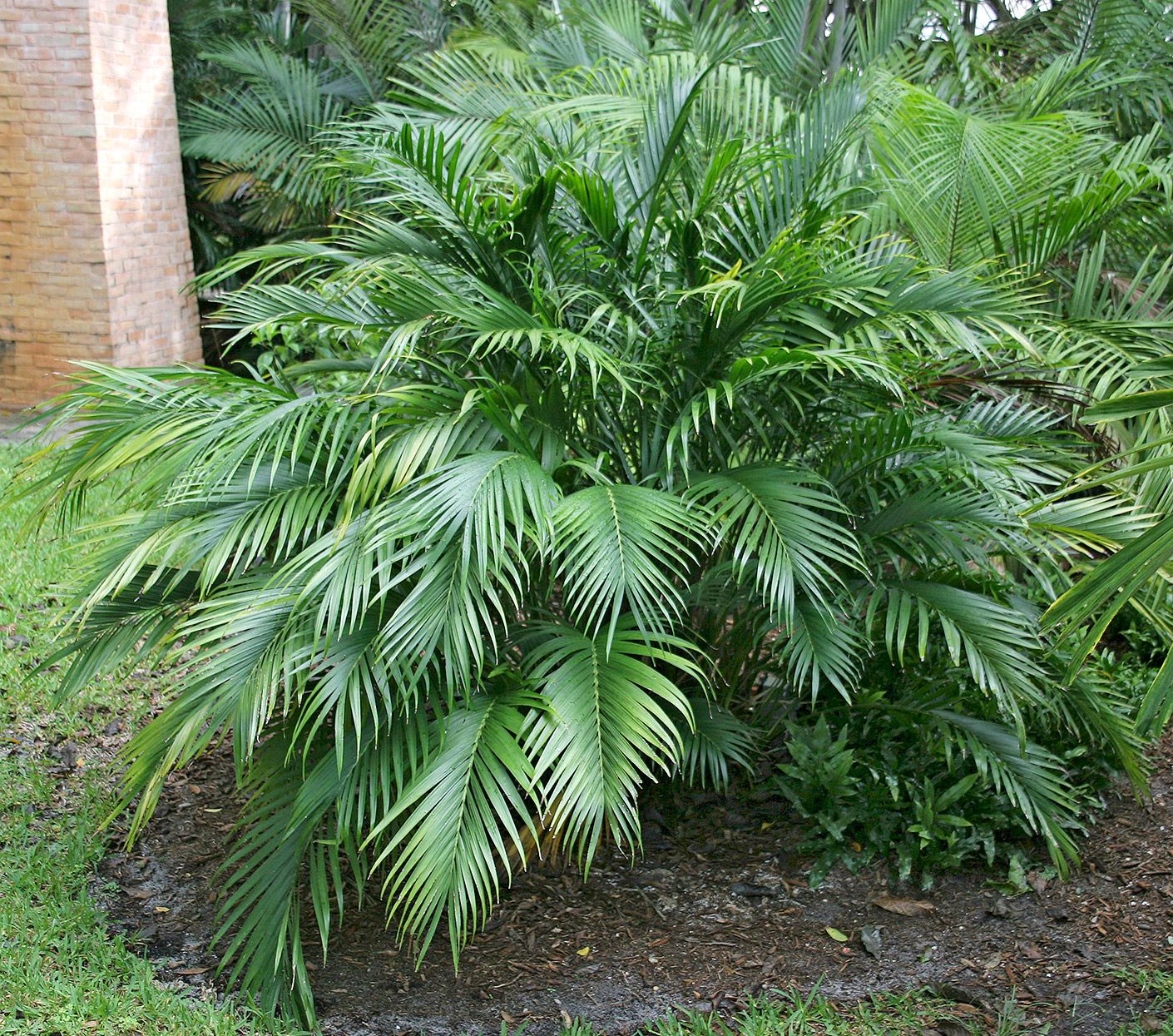
The Bamboo Palm, scientifically known as Chamaedorea seifrizii, is a popular and graceful indoor palm celebrated for its slender, bamboo-like stems and lush, green fronds. Let’s delve into its key features and care tips:
Key Features:
Bamboo-like Appearance: The Bamboo Palm gets its name from its slender, bamboo-resembling stems. It features clusters of arching, pinnate fronds that give it an elegant and tropical look.
Air Purification: Recognized for its air-purifying qualities, the Bamboo Palm is effective in removing indoor pollutants such as benzene, trichloroethylene, and formaldehyde.
Adaptability: This palm species is adaptable to a variety of indoor environments, thriving in bright, indirect light but also tolerating lower light conditions. It’s a versatile choice for homes and offices.
Compact Size: The Bamboo Palm is relatively compact, making it suitable for smaller spaces. It’s an excellent choice for those looking to add a touch of greenery without overwhelming the room.
Low Maintenance: While it requires regular care, the Bamboo Palm is relatively low-maintenance, making it a popular choice for indoor plant enthusiasts.
Care Tips:
Light: Provide bright, indirect light for optimal growth. While it can tolerate lower light conditions, too little light may result in leggy growth.
Watering: Keep the soil consistently moist, but avoid overwatering to prevent root rot. Allow the top inch of soil to dry out before watering again.
Humidity: Bamboo Palms appreciate higher humidity levels, making them suitable for well-humidified indoor spaces. Regular misting can help maintain optimal conditions.
Temperature: Maintain a warm and stable environment. Protect the palm from drafts and sudden temperature fluctuations, especially during the colder months.
Fertilization: Feed the Bamboo Palm with a balanced liquid fertilizer every 4-6 weeks during the growing season (spring and summer). Reduce or eliminate fertilization in the dormant season (fall and winter).
Whether you’re aiming to create a tropical atmosphere in your living space or enhance air quality, the Bamboo Palm is a versatile and aesthetically pleasing choice that brings a touch of the tropics indoors.
Golden Pothos (Epipremnum aureum)
A versatile and easy-to-care-for plant that excels at removing indoor air pollutants, including formaldehyde, benzene, and xylene.
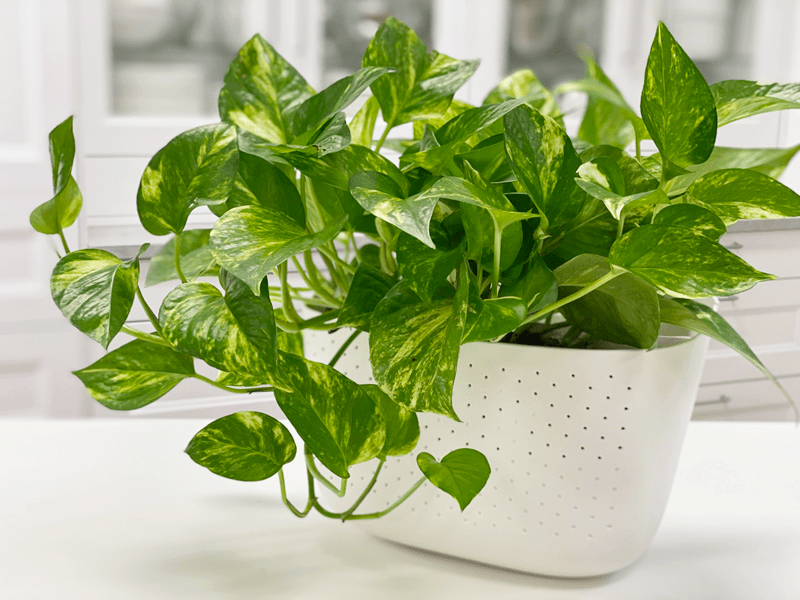
The Golden Pothos, scientifically known as Epipremnum aureum, is a popular and versatile indoor plant admired for its trailing vines, heart-shaped leaves, and ease of care. Here’s a closer look at its key features and care tips:
Key Features:
Trailing Vines: Golden Pothos is known for its cascading or trailing vines, making it an excellent choice for hanging baskets or as a trailing plant on shelves and furniture.
Heart-shaped Leaves: The leaves of the Golden Pothos are heart-shaped, typically variegated with shades of green and yellow, giving it a vibrant and attractive appearance.
Air Purification: Recognized for its air-purifying qualities, the Golden Pothos is effective in removing indoor pollutants such as formaldehyde, benzene, and xylene.
Adaptability: This plant is highly adaptable to different light conditions, thriving in both bright, indirect light and lower light levels. It’s well-suited for various indoor environments.
Low Maintenance: Golden Pothos is known for its resilience and low-maintenance requirements, making it an ideal choice for beginners or those with busy schedules.Care Tips:
Light: While it can tolerate lower light conditions, providing bright, indirect light encourages optimal growth and variegation. Avoid prolonged exposure to direct sunlight.
Watering: Allow the top inch of soil to dry out between waterings. Golden Pothos is forgiving of occasional underwatering but should not be kept consistently dry.Soil: Well-draining potting mix is suitable. Ensure the pot has drainage holes to prevent waterlogging.
Temperature: Maintain average room temperatures. Golden Pothos is adaptable to a range of temperatures but should be protected from drafts and extreme fluctuations.
Fertilization: Feed the plant with a balanced liquid fertilizer every 4-6 weeks during the growing season (spring and summer). Reduce or eliminate fertilization in the dormant season (fall and winter).
Whether you’re looking to add a touch of greenery to your home or improve air quality, the Golden Pothos is a versatile and aesthetically pleasing choice that requires minimal effort to thrive.
The Golden Pothos, scientifically known as Epipremnum aureum, is a popular and versatile indoor plant admired for its trailing vines, heart-shaped leaves, and ease of care. Here’s a closer look at its key features and care tips:
Key Features: Trailing Vines: Golden Pothos is known for its cascading or trailing vines, making it an excellent choice for hanging baskets or as a trailing plant on shelves and furniture.
Heart-shaped Leaves: The leaves of the Golden Pothos are heart-shaped, typically variegated with shades of green and yellow, giving it a vibrant and attractive appearance.
Air Purification: Recognized for its air-purifying qualities, the Golden Pothos is effective in removing indoor pollutants such as formaldehyde, benzene, and xylene.
Adaptability: This plant is highly adaptable to different light conditions, thriving in both bright, indirect light and lower light levels. It’s well-suited for various indoor environments.
Low Maintenance: Golden Pothos is known for its resilience and low-maintenance requirements, making it an ideal choice for beginners or those with busy schedules.Care Tips:
Light: While it can tolerate lower light conditions, providing bright, indirect light encourages optimal growth and variegation. Avoid prolonged exposure to direct sunlight.
Watering: Allow the top inch of soil to dry out between waterings. Golden Pothos is forgiving of occasional underwatering but should not be kept consistently dry.Soil: Well-draining potting mix is suitable. Ensure the pot has drainage holes to prevent waterlogging.
Temperature: Maintain average room temperatures. Golden Pothos is adaptable to a range of temperatures but should be protected from drafts and extreme fluctuations.
Fertilization: Feed the plant with a balanced liquid fertilizer every 4-6 weeks during the growing season (spring and summer). Reduce or eliminate fertilization in the dormant season (fall and winter).
Whether you’re looking to add a touch of greenery to your home or improve air quality, the Golden Pothos is a versatile and aesthetically pleasing choice that requires minimal effort to thrive.
Gerbera Daisy (Gerbera jamesonii):
In addition to its vibrant appearance, the Gerbera Daisy helps remove pollutants like trichloroethylene and benzene from the air.
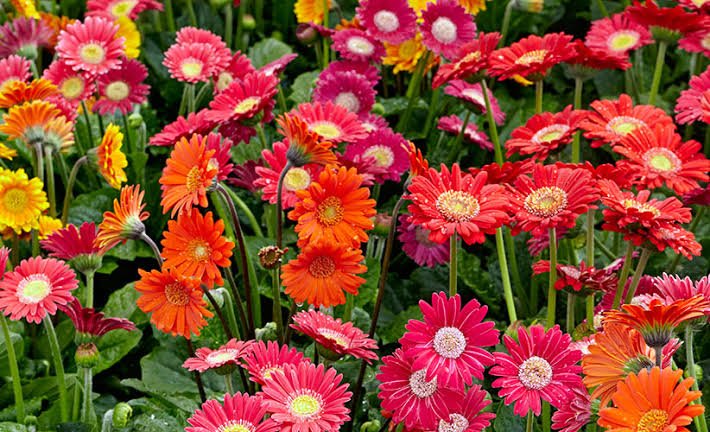
The Gerbera Daisy, scientifically known as Gerbera jamesonii, is a vibrant and cheerful flowering plant admired for its large, colorful blooms.
Here’s a closer look at its key features and care tips:
Key Features:
Colorful Blooms: Gerbera Daisies are known for their large, daisy-like flowers that come in a variety of bright and vivid colors, including shades of red, pink, orange, yellow, and white.
Long Stems: The flowers of Gerbera Daisies are supported by long, sturdy stems, making them popular choices for cut flower arrangements and bouquets.Air Purification: While not as well-known for air purification as some other indoor plants, the Gerbera Daisy can contribute to a positive indoor environment.
Adaptability: While typically grown outdoors, Gerbera Daisies can also thrive indoors, given the right conditions. They are often used as potted plants or decorative additions to indoor gardens.Seasonal Blooms: Gerbera Daisies are known to bloom in cycles, providing bursts of color during their flowering seasons.
Care Tips: Light: Provide bright, indirect light for Gerbera Daisies. They benefit from exposure to sunlight but should be protected from intense midday sun.
Watering: Keep the soil consistently moist but not waterlogged. Water when the top inch of the soil feels dry. Ensure proper drainage to prevent root rot.
Temperature: Gerbera Daisies prefer moderate temperatures. Protect them from drafts and extreme temperature fluctuations.
Humidity: While they can adapt to average indoor humidity, Gerbera Daisies appreciate slightly higher humidity levels. Regular misting can provide additional moisture.
Soil: Use well-draining potting mix to prevent waterlogging. A soil mix designed for flowering plants or general-purpose potting soil is suitable.
Fertilization: Feed the Gerbera Daisy with a balanced liquid fertilizer every 4-6 weeks during the growing season (spring and summer). Reduce or eliminate fertilization in the dormant season (fall and winter).
Whether you’re cultivating Gerbera Daisies for their vibrant blooms or adding a splash of color to your indoor space, they can be a delightful and rewarding addition to your plant collection.These plants not only add a touch of greenery to your space but also contribute to a healthier indoor environment by purifying the air.


